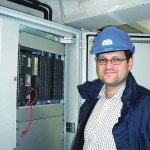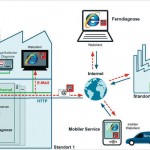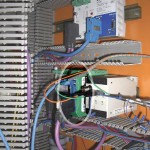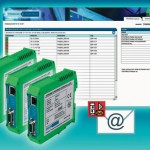Two thirds of all users consider permanent monitoring of Profibus networks a necessity. Nevertheless, only a few have actually implemented it today. This could be due to the lack of solutions that can be implemented easily and without major effort and expense. Trebing & Himstedt now provides a remedy in the shape of its xEPI 2 with integrated diagnostics and other valuable functionalities. At Evonik Goldschmidt, this web based tool has already passed its first real application test with flying colours.
Dr. Christine Eckert
The Trebing & Himstedt xEPI 2 – and its functionality as a diagnostic unit and configuration interface – was thoroughly tested by Evonik Goldschmidt of Essen, Germany, within the scope of a field test. This versatile gateway, which causes no interference whatsoever on the bus when operating in diagnostic mode, was implemented by the chemical company on three installations in different Profibus systems and with different Profibus masters: An Emerson DeltaV control system, a Siemens Simatic S7 and a 12 to 15 year-old A250 Schneider Electric connected to the digital communications network via a third-party Profibus card.
It did not take long for the diagnostic tool to provide the first valuable results and insights. “The Profibus isn’t something that breaks down constantly. When it’s up and running, it keeps running“, says Dirk Deckers, who works in the Electrical Engineering and Process Control Service Department at Evonik Goldschmidt’s Consumer Specialities business unit in Essen. “Although the bus seemed to be functioning perfectly, for the first time ever we realised all the things going on on the bus and immediately identified scores of irregularities.“ For the most part, the malfunctions could be removed immediately by minor reconfigurations of channel diagnostics. The site service engineers, also responsible for supervising all installations at the site in addition to project handling, worked through the remaining diagnostics telegrams at the next opportunity, in order to ease the load on the bus and stop it from being constantly concerned with itself.
Troubleshooting in next to no time
As the test application progressed, Deckers’ absolute favourite feature quickly emerged: the automatic email alert function. After starting his computer, he immediately knows whether there are any problems or not – even more quickly than the company itself in some cases. In the engineer’s words, “The best thing about it is that I simply have to start searching and checking to see if there is an email in my inbox. All I want to know is if there has been a problem or change on the bus. That’s all I really care about“. He then adds, “Besides, the integrated diagnostic functionality narrows down the troubleshooting step considerably“. This is because the ingenious tool informs the user whether the problems are due to the bus or to a failed channel. No time is wasted dealing with a bus failure when just a single channel is faulty. The potential error sources are reduced to the card and the device itself.
Evonik’s equipment is subjected to ongoing optimisation processes; there is always some modification or extension taking place. The bus runs stably but is inevitably affected. It’s like open-heart surgery – including the high risk of error. Incorrectly attached bus connectors, for example, can turn the DP line into an antenna and cause (partial) downtime. Such failures are hard to identify. Mostly, things still keep running smoothly, but if not, Deckers and his colleagues are faced with a real challenge. Valuable production hours may have to be spent pinpointing the source of the trouble. With permanent monitoring of the Profibus network, on the other hand, whoever is in charge can track exactly what kind of work has been done when and where – which means that failures can be located much more quickly. Translated into practice, Deckers and his colleagues recently encountered the following situation: within the scope of commissioning work on a running system, the new bus station that had been connected did not automatically log onto the bus. Deckers was able to fix things easily in next to no time. “It was fairly obvious that the device’s Profibus interface was what was defective. We therefore exchanged it and were done with it. Thanks to this Trebing & Himstedt tool, I can – and will – only win with every future implementation“, is how the engineer describes the situation.
In a worst-case scenario, firms expect standby engineers to react quickly, even at night. Yet if it takes an hour for a colleague to arrive on the spot, “quick” becomes somewhat relative. The solution: the colleague on call boots his notebook before leaving home, logs onto the terminal server via a secure, so-called demilitarised zone (DMZ), launches the Web interface and diagnoses the production network. In a matter of minutes, he can inform the electrician where to look for the failure. “The xEPI 2 has dramatically reduced our reaction times. A few hours of batch plant downtime can easily amount to a loss of 50,000 euros or more, depending on the product“, Deckers emphasises. “If there is a device available in the market that I can purchase at a fraction of this sum, I surely don’t have to think twice“. Turck is another company that believes in this cost-saving gateway and has integrated the solution into its own product portfolio.
These numerous advantages are rounded off by ease of use and security. Firstly, handling of this smart diagnostics tool is simple and intuitive; secondly, users are not forced to install any software to make it operable – an inestimable benefit. “Everything web-based facilitates our work. We don’t have to do any updates and so we won’t have any problems with software versions“, notes a pleased Deckers. And where IT security is concerned, tools that work on the basis of Web browsers definitely have the edge.
From the desk directly into the device
The initial basic function of the Ethernet-Profibus Interface was quite different, however: as the name suggests, the original purpose of first-generation gateways was to connect the production network to the fieldbus level, to enable field devices to be configured centrally and in a non-proprietary way. “There are several manufacturers who provide pure Profibus access“, explains Deckers. “That’s nice to have. But what is really clever about the xEPI 2 in the end is its permanent bus monitoring ability. The device is always in action; it provides me with information and keeps me up to date“. Users simply have to switch online between the different functionalities supported by the gateway.
Despite placing the main focus on the diagnostic functionality, the Electrical Engineering and Process Control Service Department also appreciates the value of the bus access. If necessary, it allows staff to see directly inside the transducer from the comfort of their desks. They can even adapt a scale range or reset to zero. A smiling Deckers continues: “With this integration, we can diagnose a good many things without leaving our desks, and can comprehensively inform ICA electricians in advance. That’s a pretty convenient benefit. The only thing is, we are now a little short of exercise“. In the past, this was never a problem: the engineer concerned had to tuck his laptop under his arm, jump onto his bicycle, hurry into the plant and set to work checking the cables. “What kind of environment do I have here?” “Can I connect via Hart or do I have to hook up directly onto the transducer?” “Do I have the right laptop, in other words the right software?” Only then could service personnel access the respective device, configure it or start troubleshooting. Today, the xEPI 2 allows access to all Hart based sensors via FDT device integration technology without having to get up from the desk. “This is great, a really neat piece of work. It was only today that I used this feature again. In one plant, the pumps were mounted on rubber pads. Suddenly, the container level was wrong because that physical elevation changed the suction position. We simply adjusted the respective parameters, even after the modification had been approved and released by the company. We were finished in ten minutes“, Deckers recalls. An enormous amount of time and money is saved overall.
By the summer, Evonik hopes to complete a plant that is one hundred percent Hart based and can thus be configured entirely using Pactware, the free FDT frame application. The chemical company is unwilling to accept any compromises. If suppliers cannot provide the required device drivers (DTMs) for their products, it has no hesitation in working with other, similar manufacturers who move with the times.
A tool with genuine added value
For Evonik Goldschmidt, the ability to act as a central access point for non-proprietary field device configurations is an additional benefit. The single most important aspect and advantage, however, is the diagnostic functionality. “In new plants and systems, we therefore intend to use the xEPI 2 for permanent monitoring of our Profibus networks from the outset; all existing installations will be successively retrofitted with the tool as soon as possible“, says Deckers, summing up. The diagnostic unit is the first solution of its kind to support simultaneous and continuous monitoring of a large number of Profibus networks during operation. With comparatively little effort and no special know-how, problems can be identified at a very early stage and causes of malfunctions located extremely quickly. At the chemical corporation’s facility in Essen, which is operational 24 hours a day, seven days a week and 363 days a year, the smart gateway greatly contributes to minimising unscheduled downtime, increasing availability and saving a lot of time and money. The Trebing & Himstedt xEPI 2 is a cost-efficient, competitive all-rounder that has quickly become indispensable.
Hall 10.1, Booth F36
Online-Info www.cpp-net.com/2209456
Share:










